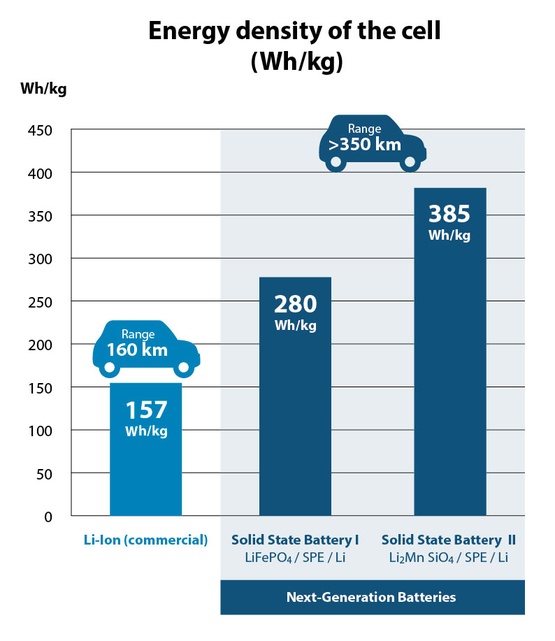Montréal, May 13, 2015
Press Release
Next-Generation Batteries: Major Innovations by Hydro-Québec and CIC Energigune
Major innovations from Hydro-Québec’s research institute (IREQ) and CIC Energigune pave the way for a generation of batteries that will succeed lithium-ion batteries in transportation electrification.
This Solid State Battery technology will lead to the development of safe, powerful, inexpensive batteries thanks to two main innovations. The first innovation is that the technology uses a solid electrolyte and the second is that the anode is made of metallic lithium with a specially treated surface.
Lithium-ion batteries, which dominate the cell-phone and electric-vehicle markets, offer EVs a range of around 160 km. But this generation is approaching its top performance. These batteries also have some safety issues, as the liquid electrolytes are flammable.

“Our technology will lead to batteries with a range of more than 350 km per charge,” explained Karim Zaghib, Manager – Energy Storage and Conversion, at Hydro-Québec. “It’s a mature, really powerful technology and it will be ready to bring to market very soon.”
“This technology marks a significant advance, with a higher density than lithium-ion batteries, thanks to the use of metallic lithium for the anode,” said Jesús M.Goiri, General Director at CIC Energigune. “The new batteries are also safer, with a solid electrolyte that is nonflammable, unlike liquid electrolytes.”
“The next frontier is indeed metallic lithium, as it allows batteries to reach high energy densities without resorting to unsustainable elements, such as cobalt”, said Michel Armand, searcher at CIC Energigune. “A simple, green, iron derivative can be used. Furthermore, less copper is needed to assemble the battery.”
This technology was presented in an article that appeared in the prestigious scientific journal Nano Letters. For the first time, the researchers have showed cross-sections of a charged and discharged battery under a scanning electron microscope.Note that this scientific breakthrough is related to the one Hydro-Québec announced in February 2015, involving the cathode, the other basic component of rechargeable batteries.
Reference
P. Hovington, M. Lagace?, A. Guerfi, P. Bouchard, A. Mauger, C. M. Julien, M. Armand and K. Zaghib, “New Lithium Metal Polymer Solid State Battery for an Ultrahigh Energy: Nano C?LiFePO4 versus Nano Li1.2V3O8,” Nano Letters, 15:4 (2015).
About CIC Energigune
CIC Energigune is the new energy research centre with headquarters in the Basque Country, Spain, which aims become a leading player on the international scientifice scene.. Its research is focused on materials science and is geared towards energy storage applications. The institution has invested more than €40 million during the last 6 years and counts on the collaboration of more than 70 researchers working with the most advanced research equipment in its field. For more information, visit www.cicenergigune.com or follow us on twitter (@cicenergigune).
About Hydro-Québec
Hydro-Québec generates, transmits and distributes electricity. It is Canada’s largest electricity producer and is among the world’s largest hydropower producers. Its sole shareholder is the Québec government. Its research institute, IREQ, conducts R&D in energy efficiency, energy storage and other energy-related fields. Hydro-Québec invests $100 million in research every year. For more information, visit www.hydroquebec.com.
Information
Hydro-Québec
Marc-Antoine Pouliot
514 289-5005
pouliot.marc-antoine@hydro.qc.ca